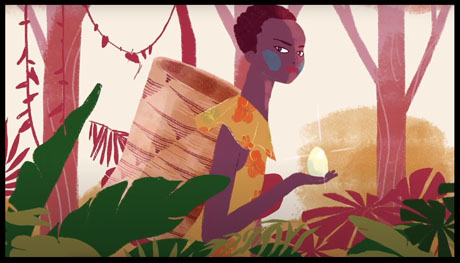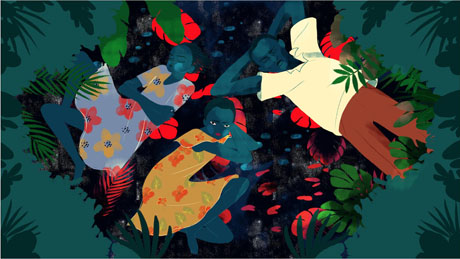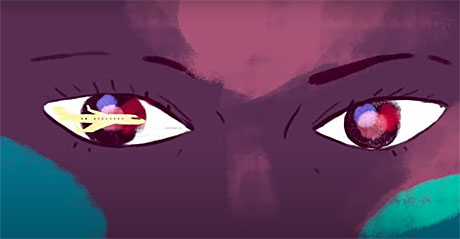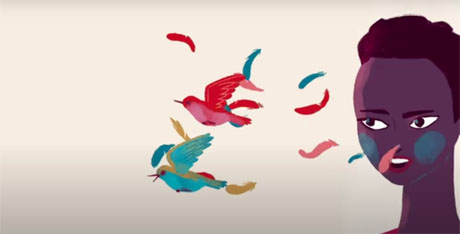
More Than I Want to Remember screened earlier this year at the Tribeca Film Festival. It’s now available to watch on Paramount+ and is one of the 15 finalists for the 2023 Best Animated Short Film Oscar. Director Amy Bench presents the story of Mugeni Ornella. At age 14, she became separated from her family and travelled from her home in the Congo to the United States, yearning for some true happiness. It’s an incredible journey, filled with courage and a love of family. Bench, Ornella, animation director Maya Edelman and key animator Sebastian Bisbal join me for this Animation Scoop Q&A. (This interview was conducted as an Email Q&A and was edited for length and clarity.)
Jackson Murphy: You’ve had quite a year, with Tribeca, Paramount+, and now this Oscars shortlist recognition, among other honors. What has the past year been like for you, with “More Than I Want to Remember”?
Amy Bench: This year has been really exhilarating. We’ve had a number of moments when we’ve had to pinch ourselves. The first of those moments was when we won an award at SXSW, where the film premiered, and getting to see Mugeni accept the award and speak in front of hundreds about the Banyamulenge people and what they’ve been enduring. Another of those moments was showing the film at Tribeca, where we won Best Animated Short and our film qualified for the Oscars. And having the legendary documentary producer Sheila Nevins come on as an Executive Producer after she fell in love with the film was so surreal in the best possible way. We’ve gotten to meet some heroes of animation along the way, who’ve been blown away by the art and story, which has been really humbling. And having perfect strangers come up after screenings and describe how the film touched them personally—there’s nothing like it. It’s been really great to see this story get the attention it deserves. Any time you put all the creative energy you have in a project, you hope it sails — and to see this one sail as it has, has made me very, very proud. I’ve been so incredibly lucky to work with Mugeni and our creative team to bring this project to life.

JM: Mugeni’s story is so powerful. What makes animation the perfect medium for it to be properly told?
AB: Animation is a wonderfully versatile medium when it comes to telling real stories. One reason animation works so well for this film is that it allows Mugeni’s voice — and the details and emotion of her story — to be in the foreground. The visuals are stunning but they allow the viewer space to be with Mugeni, as she brings us through her experiences. I love symbols and metaphors, and there are several in this film; representing power, isolation, fear, migration. Animation allows you to go to all these places in your mind, it allows a kind of personal abstraction—which can make Mugeni’s story of displacement feel very universal and easy to connect with.
JM: What were your goals with the pacing? It feels just right in how we’re able to learn, process and reflect on every important piece of information.
AB: Our goal was to bring each viewer along on Mugeni’s physical and emotional journey. A lot of the story pacing was established in the early paper and audio edits, and then we further refined our pacing as we began to animate, allowing certain places to breathe more if they went by too quickly. Pacing is really important to the animations themselves, and finding that balance between subtle movement and expressiveness, so that a viewer has the right amount of space to process certain moments.

JM: What amazes you about seeing your journey come to life through animation?
Mugeni Ornella: It feels really good. I imagine where I came from, and then I see where I am now, and it motivates me to keep going. When the first character designs were ready, I thought, “That’s exactly me!” They were so beautiful. In some of the designs I had on earrings. My foster dad gives me earrings for Christmas each year so it was really perfect. The drawings really captured my personality. They were so real to me. When I see myself animated on screen, and my story, I’m excited that my story can be shared with so many people, and hopefully that excitement is experienced by those watching the film.
JM: Your narration is so honest and real. What were your goals in how you wanted to tell your story?
MO: Some of the parts of my story are really hard to talk about. But it was really important to me to tell the whole story, for two reasons. First, I wanted to inspire people to help refugees. Kindness costs nothing. If you’re good to somebody else, it will find its way back to you or your grandchildren. And, I want other refugees to realize that no matter what happens in your life, there will be a day that you will be smiling again. I want people to know that no matter what’s going on today or tomorrow, that’s not the end of the story. Your life might change tomorrow. You just have to believe.

JM: Emotions are so key, especially those we see in Mugeni, in both upbeat and more serious sections. How did you want to present emotion?
Maya Edelman: In addition to designing layouts for scenes with the characters emoting with gestures or facial features I chose to include metaphorical stand-ins for emotions, such as fire for fear, eggs as an overall metaphor for the alienated experience of immigration, forest for wandering and isolation. And I used color to express both positive and negative emotions.
JM: The colors are quite beautiful, from the forest at night to the clothing. Which sequence really stands out to you?
ME: For me the two strongest sequences in terms of color are the attack on Mugeni’s village and the nightmare, both for similar reasons. The colors in the village attack scene are really effective at communicating fear with the darkness of the enclosed spaces and the reds of the blaze outside. The colors in the nightmare scene serve to make it an elaboration and a more surreal continuation of the themes in the village attack scene.

JM: What were your goals in capturing the spirit and confidence of Mugeni as an animated character?
Sebastian Bisbal: Since we are talking about a real person with a real story, as a team, we tried to show the humanity behind the art. We tried really hard to show that Maya’s drawings were alive. Those weren’t just objects moving. We have human beings being represented by drawings in motion. There were lots of subtleties in terms of emotions to animate, and since there is a minimalist style established in the short, we tried to convey the true emotion behind an expression, but always trying not to exaggerate too much.
JM: This is a short about hope. Which sequence that you worked on do you think showcases hope the most?
SB: Well, this will be a spoiler, but I think the most hopeful sequences in the film are the ones when she discovers that her mom is alive and she is able to talk to her, and later see and hug her. I think that whole sequence is very telling and moving, that behind all the suffering and pain of her journey, she never lost hope and she just kept going. And that’s why those sequences were very challenging in terms of animation, because we really wanted to do it in a way that conveys the true emotion behind it all.
JM: What would an Academy Award nomination, and possibly a win, mean to you?
AB: To make the shortlist has been a dream. If our film received a nomination, it would mean the world to me. And, of course, I would love to see Mugeni up on the Oscar stage, soaking up all the love that people have for her and her incredible story of hope and resilience.
- INTERVIEW: Jeff Fowler On “Knuckles” And “Sonic 3” - April 22, 2024
- INTERVIEW: “Inside Out 2” Director And Producer On Pixar Sequel - April 16, 2024
- INTERVIEW: “Puffin Rock And The New Friends” And 25 Years Of Cartoon Saloon - April 10, 2024


 January 15th, 2023
January 15th, 2023  Jackson Murphy
Jackson Murphy  Posted in
Posted in  Tags:
Tags: 






